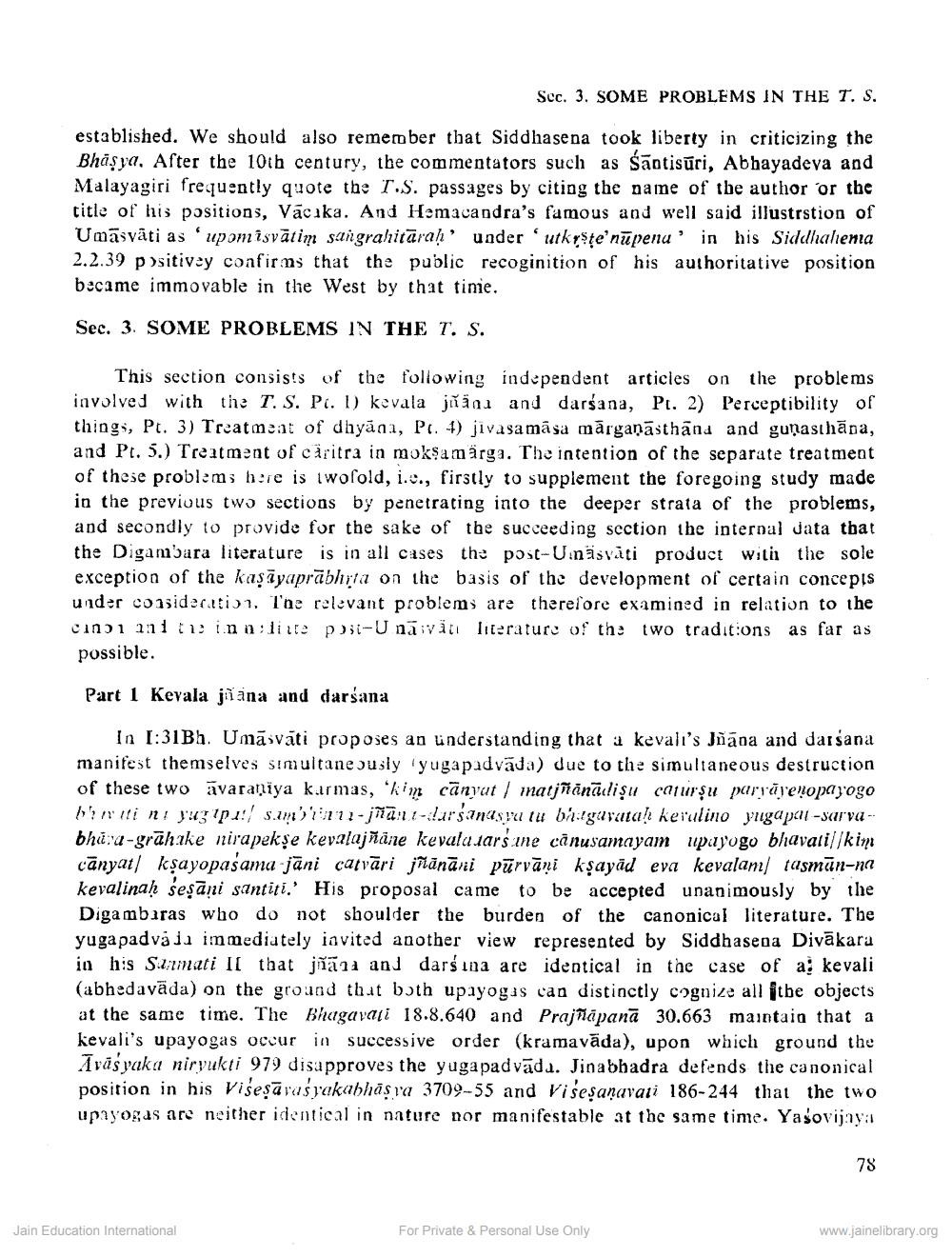________________
Sec. 3. SOME PROBLEMS IN THE T. S. established. We should also remember that Siddhasena took liberty in criticizing the Bhasya. After the 10th century, the commentators such as Santisuri, Abhayadeva and Malayagiri frequently quote the T.S. passages by citing the name of the author or the title of his positions, Vacaka. And Hemacandra's famous and well said illustration of Umasvati as 'upomisvātim sangrahitāraḥ under utkṛṣṭe'nupena in his Siddhahema 2.2.39 positivey confirms that the public recoginition of his authoritative position became immovable in the West by that time.
Sec. 3. SOME PROBLEMS IN THE T. S.
This section consists of the following independent articles on the problems involved with the T. S. P. 1) kevala jääa and darsana, Pt. 2) Perceptibility of things, Pt. 3) Treatment of dhyana, Pt. 4) jivasamāsa marganasthana and gupasthana, and Pt. 5.) Treatment of caritra in mokṣamärgs. The intention of the separate treatment of these problems here is twofold, i.c., firstly to supplement the foregoing study made. in the previous two sections by penetrating into the deeper strata of the problems, and secondly to provide for the sake of the succeeding section the internal data that the Digambara literature is in all cases the post-Umäsvati product with the sole exception of the kaşayaprabhṛta on the basis of the development of certain concepts under consideration. The relevant problems are therefore examined in relation to the canon and the inalite post-Unawat literature of the two traditions as far as possible.
Part 1 Kevala jana and darsana
In 1:31Bh. Umasvati proposes an understanding that a kevali's Juana and darsanal manifest themselves simultaneously (yugapadvada) due to the simultaneous destruction of these two avarapiya karmas, 'kin canyat matjänadişu courşu paryayeṇopayogo biti ni yuzip!/ sam'b'inni-jñāni-darśanasya tu bhagavataḥ kevulino yugapai-sarvabhara-grahake nirapakşe kevalajane kevala.sarsane canusamayam upayogo bhavall//kin canyat kṣayopasama jani catvari manāni pārvāni kṣayad eva kevalam tasman-na kevalinaḥ śeşani santiti.' His proposal came to be accepted unanimously by the Digambaras who do not shoulder the burden of the canonical literature. The yugapadvaja immediately invited another view represented by Siddhasena Divākara in his Sarmati II that jñana and darsina are identical in the case of a kevali (abhedavāda) on the ground that both upayogis can distinctly cognize all the objects. at the same time. The Bhagavati 18.8.640 and Prajapana 30.663 maintain that a kevali's upayogas occur in successive order (kramavāda), upon which ground the Avasyaka niryukti 979 disapproves the yugapadvada. Jinabhadra defends the canonical position in his Višeṣāvasyakabhāṣva 3709-55 and Viseṣaṇavati 186-244 that the two upayogas are neither identical in nature nor manifestable at the same time. Yasovijaya
Jain Education International
For Private & Personal Use Only
78
www.jainelibrary.org




